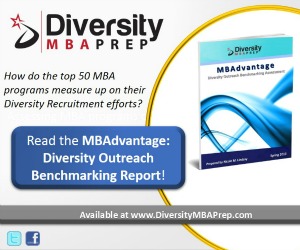The MBAdvantage Diversity Recruitment framework assesses business schools on their diversity outreach practices on four major categories:
- MBAdvantage Report
- Web and Social Media
- Activities and Outreach
- School Leadership
- Diversity Recruitment Results
-
The MBAdvantage: Diversity Outreach Benchmarking Report offers a framework for evaluating business schools’ approaches to attracting and retaining women and under-represented minorities. The MBAdvantage Report, designed to advance the dialogue on increasing student diversity of MBA programs, assesses more than 50 top MBA programs on 22 factors related to their:
- Web and Social Media Presence
- Outreach and Recruiting Activities
- School Leadership, and
- Diversity Recruitment Results
The MBAdvantage Report includes a summary of data, findings, and recommendations along with individual assessments of each MBA program. The MBAdvantage Report does not evaluate a school’s commitment to diversity and inclusion, nor consider the experiences of its women and minority MBA students. The report card assessment provides a letter grade (of A, B, C, D, or F) on each category outlined above as well as an overall letter grade for each school; the report does not rank business schools against one another.
The information used to complete the school assessments is generally publicly available information, readily accessible on school websites. Each school had the opportunity to supplement what is contained on its website.
-
Candidate Perspective: Web and Social Media
The Candidate Perspective – Web and Social Media category measures how well an MBA program represents diversity on its website and on social media. Recognizing that the majority of MBA candidates begin their school research by visiting school websites, this category evaluates the initial diversity contact points that candidates have with MBA programs. The factors assessed are:
• Visual representation, through photographs, video, and other multimedia, of diversity, including women and people of color on the school’s website
• Inclusion of a dedicated diversity page and content on the school’s website
• Ease of locating the diversity page and content on the website
• Placement of the diversity page and content on the website, namely the number of clicks to reach the page from the home page
• Inclusion of multiple diversity pages or content which separately addresses minorities and women
• Social media presence on Twitter and Facebook
-
Candidate Perspective: Activities and Outreach
The Candidate Perspective – Activities and Outreach category assesses business schools’ activities and outreach, specifically aimed at attracting women and under-represented minorities. This measures mostly admissions activities. In identifying the resources that exist for candidates to engage with MBA programs, the factors considered are:
• Presence of diversity-focused MBA Admissions or recruitment staff
• Women- and ethnicity-focused events, targeting or welcoming MBA candidates
• Student clubs targeting women and minorities
• Partnerships and resources that support diversity recruiting
-
School Leadership
While the admissions team is tasked with candidate outreach, it is business school leadership that sets the institution’s direction and priorities. The School Leadership category reflects what and who are guiding the Dean, and considers the following factors:
• Incorporation of diversity within the school’s mission statement
• School’s diversity statement
• Gender representation on the school’s leadership team
• Gender representation on the Dean’s advisory board or council
• School-wide diversity representative or officer
-
Diversity Recruitment Results
The Diversity Recruitment Results category measures the admissions outcomes for women and under-represented minorities reported by MBA programs. There are many factors, such as a school’s reputation, geographic location, and financial support that impact a candidate’s decision to matriculate to a particular MBA program, and thus impact the demographics of the student body. This category assesses results, but emphasizes transparency over outcomes of the school’s gender and ethnic diversity. The factors considered include:
• Ease of locating diversity recruitment results
• Transparency/ availability of data reported on female representation in the MBA program
• Transparency/ availability of data reported on minority representation in the MBA program
• Transparency/ availability of data reported on representation of African/ Black-, Hispanic- and Native-American students in the MBA program
• Reporting of multiple years of diversity recruitment results
• Outcomes on female student representation
• Outcomes on minority and/ or African/ Black-, Hispanic- and Native-American students representation

